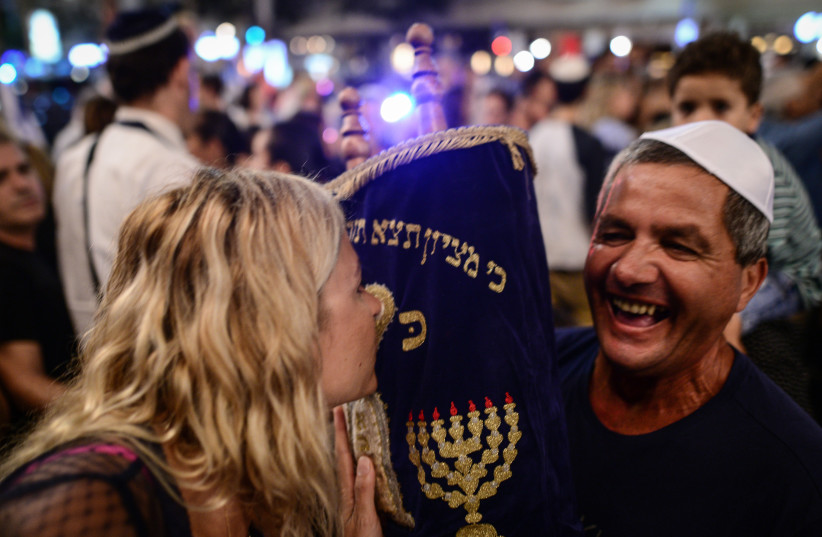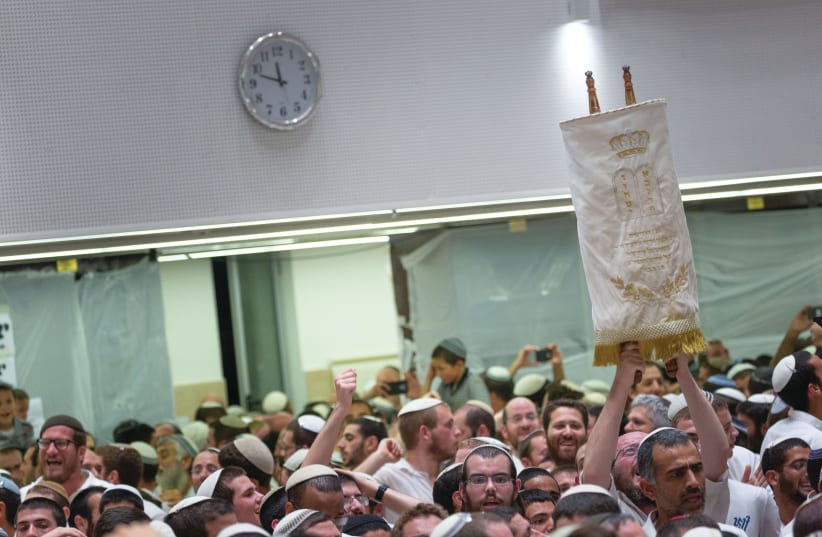This Shabbat, we will celebrate Shmini Atzeret, the holiday that concludes the festivals of the month of Tishrei – Rosh Hashanah, Yom Kippur, and Sukkot. This holiday is also known by an additional name: Simchat Torah. (In Israel, Simchat Torah is celebrated on the same day as Shmini Atzeret, while outside of Israel, Simchat Torah is observed on a separate day after Shmini Atzeret.)
On Simchat Torah, we celebrate the completion of the annual cycle of Torah reading. Every Shabbat we read one parsha, and on Simchat Torah we read the final portion of the Book of Deuteronomy, Vezot Haberachah, and immediately begin reading the first portion of the Book of Genesis, known as Bereshit.
As we celebrate the culmination of the annual Torah reading cycle, communities traditionally engage in hakafot – dancing with and around the Torah scroll. These dances express our relationship with the Torah: The Torah is not a heavy burden for us, nor do we view it as an obligation that disrupts our lives, heaven forbid.
On the contrary, we believe that the Torah is a source of happiness and beauty in our lives. When we delve into it, study its teachings, and live according to its guidance, we lead meaningful and elevated lives.
This sentiment is expressed in a song commonly sung during the hakafot: “Blessed is our God Who created us for His glory, separated us from those who err, and gave us a true Torah and implanted eternal life within us.” The Jewish people have been granted “eternal life” by God, lives that have a noble purpose, lives that shine with the light of holiness and morality for all of humanity.


The foundation for this perspective is found in the story of Creation in the Book of Genesis. Creation stories exist in various cultures. In ancient times, these stories often described gods creating the world or humanity to satisfy their needs.
Torah vs. Modern scientific era
IN THE MODERN scientific era, we often speak of the Big Bang theory to describe the origin of the universe. The Torah tells a story that can effortlessly fit in with scientific theories about Creation. While the details are important, we will focus on how the story reflects a particular perspective on the reality in which we live.
First and foremost, there is order in reality. Even though it may sometimes seem like chaos is the central feature of existence, the Torah teaches us that reality was created with remarkable order. This order provides a framework within which humans are invited to act – to perform positive deeds and refrain from negative ones.
This order is essential for us to believe that our actions have value. We do not operate in a world of randomness and chaos but in a world that was created with intention. Based on this understanding, we can take responsibility for the future and act to advance ourselves and the surrounding world.
But that’s not all. Even if reality is created and operates according to order, how do we know that it is good? Many of us may sometimes think that the basic conditions of human existence are rather bleak – a perspective occasionally reinforced by challenging experiences. However, when we examine the Creation story in the Book of Genesis, we find the opposite narrative: that reality is good.
Six times, the text repeats the phrase “And God saw that it was good,” and in the seventh instance, it summarizes by saying, “And God saw all that He had made, and behold it was very good.” The world is good. There is room for progress, optimism, and faith.
The sages of the Midrash interpret the words “And behold it was very good” as if it were written “And behold, Adam [human] was good.” (In Hebrew, the letters for “very” and for “Adam-human” are the same, albeit in a different order.)
Not only is the reality surrounding us inherently good, but humans, those beings with whom we are intimately familiar yet sometimes distant from in understanding, are also inherently good. The Torah places trust in the world and in humanity. As a result, it calls upon humans to act within reality, to believe in themselves, to understand the value of human existence – ours and others’ – and the significance of human actions, thereby attributing importance and value to our choices.
This is the fundamental perspective of the Torah. Therefore, it is no wonder that on the day we complete another cycle of Torah reading, we celebrate, rejoice, and dance, expressing our gratitude to God for the “eternal life” He has implanted within us. ■
The writer is the rabbi of the Western Wall and holy sites.
